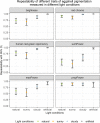Presence of the cloud cover and elevation angle of the sun affect measurements of eggshell coloration and patterning obtained from calibrated digital images
- PMID: 37435021
- PMCID: PMC10329936
- DOI: 10.1002/ece3.10170
Presence of the cloud cover and elevation angle of the sun affect measurements of eggshell coloration and patterning obtained from calibrated digital images
Abstract
Calibrated digital photography is frequently used in studies focusing on avian eggshell appearance to measure colour and pattern features. Photographs are often taken in natural light conditions, yet little is known to what extent the normalisation process is able to control for varied light. Here, we photographed 36 blown eggs of the Japanese quail Coturnix japonica at five different elevation angles of the sun on both sunny and uniformly overcast days alongside grey standards. We normalised and processed the photographs in the MICA Toolbox software and checked how much noise was introduced by different natural light conditions to the colour and pattern measurements of the same set of eggs. Our results indicate that natural variation of light conditions affects eggshell colour and pattern measurements obtained by means of calibrated digital photography. Depending on a trait, the elevation angle of the sun had similar or even greater effect on the measurement than the presence of the cloud cover. Furthermore, measurements taken in cloudy conditions were more repeatable than those taken in sunny conditions. Based on the results, we propose practical guidelines regarding measuring colour and pattern of eggshells using calibrated digital photography in outdoor conditions.
Keywords: granularity; light; normalised digital photography; repeatability; repeated‐measures ANOVA; weather conditions.
© 2023 The Authors. Ecology and Evolution published by John Wiley & Sons Ltd.
Conflict of interest statement
The authors declare no conflict of interest.
Figures




References
-
- Ahlmann‐Eltze, C. , & Patil, I. (2021). Ggsignif: R package for displaying significance brackets for 'ggplot2'. PsyArxiv 10.31234/osf.io/7awm6 - DOI
-
- Bakeman, R. (2005). Recommended effect size statistics for repeated measures designs. Behavior Research Methods, 37, 379–384. - PubMed
-
- Bergman, T. J. , & Beehner, J. C. (2008). A simple method for measuring colour in wild animals: Validation and use on chest patch colour in geladas (Theropithecus gelada). Biological Journal of the Linnean Society, 94, 231–240. 10.1111/j.1095-8312.2008.00981.x - DOI
-
- Butler, M. W. , & Waite, H. S. (2016). Eggshell biliverdin concentration does not sufficiently predict eggshell coloration. Journal of Avian Biology, 47, 491–499. 10.1111/jav.00842 - DOI
LinkOut - more resources
Full Text Sources

